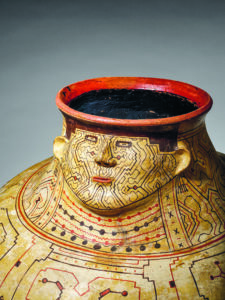A sneak peek from our Why Do We Take Drugs? book
Why do we take drugs? Our emotional and intellectual response to this question will be informed by what we consider to be a drug.

Why Do We Take Drugs? featuring Sara Flores, Untitled (Maya Kene 15 2023), 2023.
A dictionary definition identifies a drug as ‘a medicine or other substance which has a physiological (mental) effect and/ or physical effect when ingested or otherwise introduced into the body’. This could of course refer to sugar as much as it does to a Class A drug such as heroin. So where do we draw the line? At what point does a substance develop the stigmatised status of a drug? On what grounds do we distinguish between the highs offered by ‘social drugs’ such as tobacco or alcohol, and the euphoria induced by cocaine or ecstasy (MDMA)? Our reactions are possibly shaped by the following three questions:
Is it legal?
Is it ethical?
Is it safe?

Unknown artist, jar, Shipibo-Konibo, Peru, date unknown, painted terra-cotta. Courtesy of private collection

Pierre Beloüin, Dreamachine Room. © ADAGP Paris 2024/2025, Art’O’Rama Marseille, 2009, Vacances Bleues collection. Photo: Alain Sauvan
The answers to these questions may vary depending on the cultural context in which it is considered. In many parts of the globe, drug cultures have proven intrinsic to the formation of Indigenous cultural identities and are associated with the correct practice of ancestral religions and rituals. Specific medicinal plants are revered for their ability to connect the user with the spirit world and are valued for their capacity to sustain psychological and physical wellbeing. Geographical, social and environmental factors are key to understanding the various types of experiences that different drug cultures facilitate. These differences can be fully appreciated by an exploration of the decorative objects and artworks that have been created over millennia to communicate altered states of consciousness.

Robert Venosa, Ayahausca Dream, 1994. Copyright: Robert Venosa. Courtesy of Martina Hoffmann

Guadalupe Munoz, Shaman’s dreams, 2019. Copyright: Guadalupe Munoz. Image courtesy of Bienal de Arte Huichol / Arte Yawí
In Western Europe, an individual’s degree of exposure to a cornucopia of drugs is rarely if ever fully acknowledged. Anaesthetics and analgesics are core to the treatment of pain in dental surgeries and hospitals across the UK, meaning nitrous oxide or ketamine is administered prior to the extraction of a tooth, while ‘gas and air’ (nitrous oxide and oxygen) and opioids, such as pethidine and diamorphine (heroin), are used to relieve pain during childbirth or post-caesarean. We depend on the safe and responsible administration of drugs by trained doctors in a medical context and place trust in drugs that have been approved and licensed by the Medicines and Healthcare products Regulatory Agency (MHRA) in the UK.
News coverage of drug misuse, overdosing and addiction stoke public fears and prejudices that make it difficult to have open, cross-generational discussions about the legalisation of certain drugs. Recent news stories have focused public outrage on the lapse in the United States Food and Drugs Administration (FDA) regulation that enabled a nationwide addiction to the prescription painkiller OxyContin to take hold. Launching in 1996, Perdue’s OxyContin had been linked to over 122,000 deaths by 2015 2 and researchers have also documented an increase in deaths by overdose from other opioid prescription painkillers, such as Fentanyl.

Installation shot from Lindsey Mendick’s Hot Mess. Photo by Kate Wolstenholme.

Graham MacIndoe, Coming Clean. Copyright: Graham MacIndoe
The grim details of substance misuse make it difficult to focus solely on the often beautiful and expressive artistic languages that drug cultures generate. Artists sensitise us to the transformative potential of drugs, and in so doing, reveal new ways of seeing and experiencing reality. Their creative vision has the power to highlight both the positive and negative aspects of intoxication and drug use, inspiring empathy and understanding in place of suspicion and judgement. Through their works we gain access to the extremities of human thought, emotion and behaviour. Why Do We Take Drugs? attempts to strike a balance between science, nature and art by situating these contrasting discourses in diverse contemporary social contexts: from the ceremonial use of peyote in Mexico and ayahuasca in the Peruvian Amazon, to the more problematic consumption of nyaope in South Africa and heroin in North America.

Ivan Morison, Artists & Farmers: Reaper I, as part of Towards the Weird Heart of Things at the Sainsbury Centre, 2024. Photo: Ivan Morison.
Written by Vanessa Tothill, Curator of Transhistorical Narratives, Sainsbury Centre.
Discover interviews, essays and more in our Why Do We Take Drugs? book, now available at the Sainsbury Centre shop.
Find out more about the current exhibition season here.
Exhibition seasons at the Sainsbury Centre explore some of the biggest questions in our lives. Through the exploration of these topics, the Sainsbury Centre does not seek to provide answers to the questions, but rather open up dialogue and discussion. The exhibitions endeavour to provide a balanced and unbiased investigation and the Sainsbury Centre offers a safe space for everyone to learn and discover our world from multiple perspectives.
